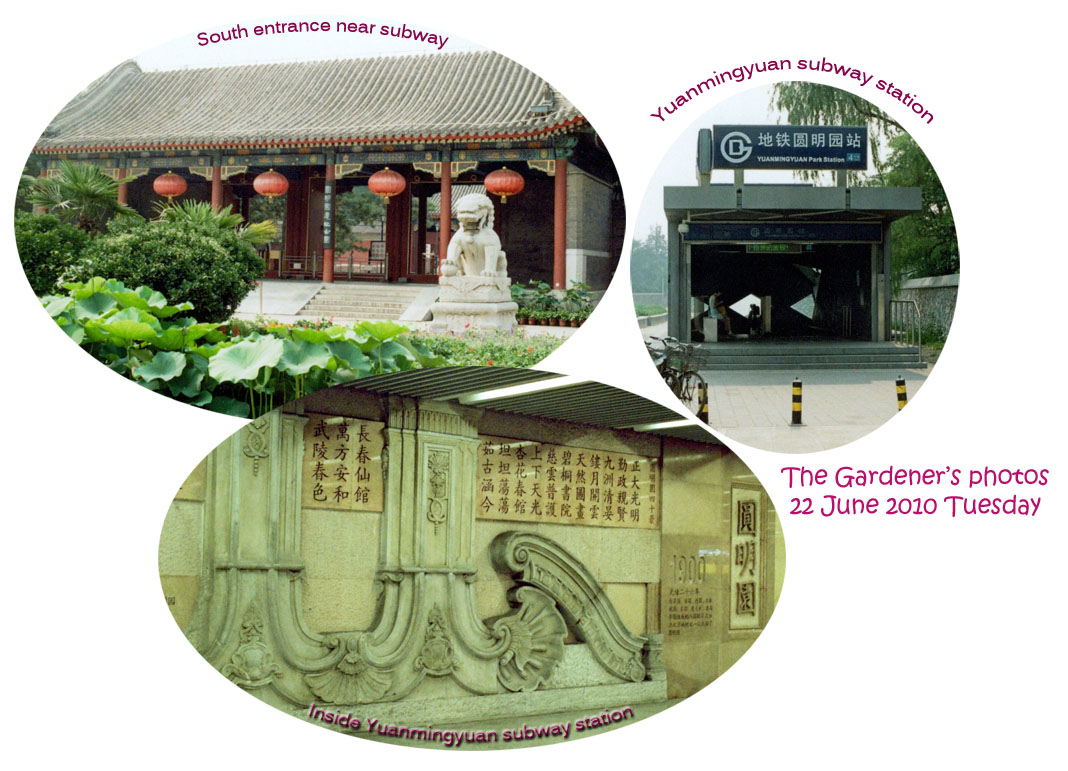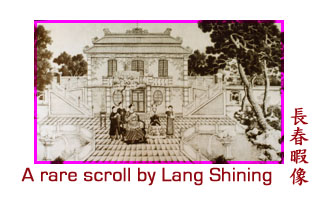THE 40 SCENERIES OF YUAN MING YUAN DETACHED PALACE
("The Garden of Perfect Brightness")


| In commemoration of the 308th anniversary of the founding of Yuan Ming Yuan, 1709-2017 |



 What is Yuan Ming Yuan?
What is Yuan Ming Yuan?
It was the garden-palace of the emperors of Qing Dynasty (1644-1912). For 150 years, six emperors usually spent
two-third of every year (from spring to right before winter solstice) there, living and reigning. It was a royal precinct:
not even high officials could tour around the garden unless invited by the emperor, although most government ministries
were represented there.
 Where is it?
Where is it?
The garden was less than 20 kilometres to the northwest of Beijing city, the capital.
 How large is it?
How large is it?
Yuan Ming Yuan (圓明園) was actually a complex of three adjacent garden-palaces, attaching to one another.
Attaching to the east side of Yuan Ming Yuan proper was Chang Chun Yuan (長春園), and attaching to the south side of both of
them was Wan Chun Yuan (萬春園). The overall area of this tripartite complex was about 3.5 sq. km, or 1.35 sq. miles.
 What are some of the special or unique features of the complex?
What are some of the special or unique features of the complex?
(1) One notable feature was the abundance of water areas in the complex. Besides the large man-made lake called Fuhai (福海)
("Sea of Auspiciousness", 0.25 sq. km),
there were two smaller lakes and numerous waterways intersecting pieces of land on which were the palatial buildings. In fact, one may
say that the land strips were all floating on water. Water came from rivers in the hilly areas west of the gardens. It was channelled
into the complex from the southwest corner, and exited the complex from the northeast corner.
(2) In Chang Chun Yuan, Emperor Qianlong had his well-known European houses designed and built by the Italian Jesuit
Giuseppe Castiglione (郎世寧) and the French Catholic priest Michael Benoist (蔣友仁). The buildings took 13 years to complete, from 1747 to 1760.
 Who developed the garden-palace?
Who developed the garden-palace?
In 1709, Emperor Kangxi (康熙) bestowed a former private garden northwest of Beijing to his son Yongzheng (雍正). Under Yongzheng and his
mighty son Qianlong, the garden-palace was expanded from 40 hectares to 350 hectares in 70 years' time.
 What happened in 1860 and since?
What happened in 1860 and since?
The Arrow War (英法聯軍之役), Anglo-French Joint Expedition) broke out in China in October 1856. In October 1860 (咸豐10年), during the
concluding stage of the war, the French and British armies entered Yuan Ming Yuan. Both armies and some Chinese civilians looted the entire garden-palace,
and the British army subsequently burnt it to the ground by order of Lord Elgin (額爾金), despite disagreement from the French side.
Lord Elgin was Governor-General of Canada from 1847 to 1854 before he became the plenipotentiary
and leader of the British expedition to China.
He has been described as a "cultured humanist and judicious administrator" (The Canadian Encyclopedia, 1988). The burning on 18th and 19th October 1860 was accomplished by an arson team of 3,500 men.
The second catastrophe befell the garden-palace in 1900, when people again looted the remains of the gardens during the
Boxer Uprisings (義和團之亂), after the emperor fled Beijing. This time apparently the culprits were the Chinese themselves: eunuchs, petty officials, bandits, scoundrels, etc.
In 1904, the Qing government withdrew most of the administrative agencies of Yuan Ming Yuan, practically abandoning the gardens.
Around the time of the Republican revolution in 1911, the garden complex was but a barren patch where only traces of relics remained.
Not unitl 1976 was a management office set up by the Chinese government to preserve and possibly restore Yuan Ming Yuan.
《圓明園》喬勻 編 (香港: 三聯書店, 1985) A pictorial.
European houses in Yuan Ming Yuan 圓 明 園 西 洋 樓
situated in the north part of Chang Chun Yuan 長 春 園
These buildings and structures exemplified Emperor Qianlong's liking for exotic
European technological gadgets. He was selective in introducing Western culture, however. Nude statues commonly found
in European gardens were not allowed in his European-style garden. Instead, traditional Chinese
bronze statues of mythological creatures and other Chinese motifs were used.
諧 奇 趣
Mainly a music hall with fountain萬 花 陣
A labyrinth 方 外 觀
Functions as an Islamic mosque 海 晏 堂
Water reservoir with fountain
遠 瀛 觀
Once residence of Xianfei 香妃, Emperor Qianlong's concubine 大 水 法
Main fountain 觀 水 法
Emperor's seat for fountain viewing 線 法 牆
Walls for displaying paintings in perspective
Twenty-eight of these sceneries were developed by Emperor Yongzheng, and twelve by Emperor Qianlong. They were completed
around 1744.
CENTRAL PART OF YUAN MING YUAN PROPER
正 大 光 明 勤 政 親 賢 九 州 清 晏 鏤 月 開 雲
天 然 圖 畫 碧 桐 書 院 慈 雲 普 護 上 下 天 光
杏 花 春 館 坦 坦 簜 簜 茹 古 涵 今 長 春 仙 館
麴 院 風 荷 洞 天 深 處
NORTH PART OF YUAN MING YUAN PROPER
武 陵 春 色 匯 芳 書 院 澹 泊 寧 靜 映 水 蘭 香
水 木 明 瑟 濂 溪 樂 處 多 稼 如 雲 魚 躍 鳶 飛
北 遠 山 村 西 峰 秀 色 四 宜 書 屋 澡 身 浴 德
廓 然 大 公 坐 石 臨 流
WEST PART OF YUAN MING YUAN PROPER
萬方安和 山 高 水 長 月 地 雲 居 鴻 慈 永 祜
日 天 琳 宇
EAST PART OF YUAN MING YUAN PROPER
方 壺 勝 境 平 湖 秋 月 蓬 島 瑤 台 接 秀 山 房
別 有 洞 天 夾 鏡 鳴 琴 涵 虛 朗 鑒
《圓明園資料集》舒牧 等編 (北京: 書目文獻出版社, 1984)
D'Herisson, Count.
"The Loot of the Imperial Summer Palace at Pekin." In Smithsonian
Institution Annual Report 1900 (1901), pp. 601-635. Translated from French. The 21-year-old
author was secretary and interpreter to the French commander, General Montauban. He was among the
first group of French personnel to enter Yuan Ming Yuan in the evening of 6 October 1860.
![]()

From Louis Chor, the Gardener. Canada, December 1998. Updated September 2016